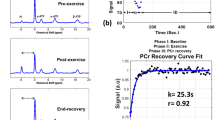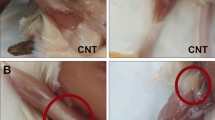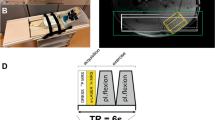Abstract
Inhibiting myostatin (mstn) causes spectacular increase in muscle mass, spurring research for therapeutic approaches against neuromuscular disorders. Yet, possible functional deterioration and compromised force production have been reported in isolated muscle of null mstn(−/−) mice. We analyzed vascular and metabolic response to repeated electro-stimulated exercise in vivo in mstn−/− mice compared with FVB wild-type controls (WT), using interleaved multi-parametric functional nuclear magnetic resonance (NMR) imaging and spectroscopy. At steady-state exercise, specific force of plantar flexion, phosphocreatine consumption measured by phosphorus spectroscopy and maximum perfusion measured by arterial spin-labeled (ASL) NMR imaging were identical in both groups. After exercise, phosphorus spectroscopy revealed reduced oxidative mitochondrial capacity in mstn−/−, whereas early recovery perfusion was identical and oxygen extraction, estimated from the blood oxygen level-dependent (BOLD) contrast, was decreased when compared with WT. Hyperemia was prolonged, indicating specific regulation of the perfusional response in mstn−/− mice. Histology showed an increased proportion of type IIb fibers in hypertrophied muscles, but the distribution of capillary contacts per fiber between oxidative and glycolytic fibers was unaltered in mstn−/− compared with WT. These integrated results formed coherent evidence of a congruous, non-pathologic shift toward a more glycolytic metabolism in this model of mstn−/−.
This is a preview of subscription content, access via your institution
Access options
Subscribe to this journal
Receive 12 print issues and online access
$259.00 per year
only $21.58 per issue
Buy this article
- Purchase on Springer Link
- Instant access to full article PDF
Prices may be subject to local taxes which are calculated during checkout





Similar content being viewed by others
References
McPherron AC, Lawler AM, Lee SJ . Regulation of skeletal muscle mass in mice by a new TGF-beta superfamily member. Nature 1997; 387: 83–90.
Grobet L, Martin LJ, Poncelet D, Pirottin D, Brouwers B, Riquet J et al. A deletion in the bovine myostatin gene causes the double-muscled phenotype in cattle. Nat Genet 1997; 17: 71–74.
McPherron AC, Lee SJ . Double muscling in cattle due to mutations in the myostatin gene. Proc Natl Acad Sci U S A 1997; 94: 12457–12461.
Clop A, Marcq F, Takeda H, Pirottin D, Tordoir X, Bibe B et al. A mutation creating a potential illegitimate microRNA target site in the myostatin gene affects muscularity in sheep. Nat Genet 2006; 38: 813–818.
Mosher DS, Quignon P, Bustamante CD, Sutter NB, Mellersh CS, Parker HG et al. A mutation in the myostatin gene increases muscle mass and enhances racing performance in heterozygote dogs. PLoS Genet 2007; 3: e79.
Schuelke M, Wagner KR, Stolz LE, Hubner C, Riebel T, Komen W et al. Myostatin mutation associated with gross muscle hypertrophy in a child. N Engl J Med 2004; 350: 2682–2688.
Patel K, Amthor H . The function of Myostatin and strategies of Myostatin blockade-new hope for therapies aimed at promoting growth of skeletal muscle. Neuromuscul Disord 2005; 15: 117–126.
Bradley L, Yaworsky PJ, Walsh FS . Myostatin as a therapeutic target for musculoskeletal disease. Cell Mol Life Sci 2008; 65: 2119–2124.
Lee SJ . Quadrupling muscle mass in mice by targeting TGF-beta signaling pathways. PLoS ONE 2007; 2: e789.
Amthor H, Nicholas G, McKinnell I, Kemp CF, Sharma M, Kambadur R et al. Follistatin complexes Myostatin and antagonises Myostatin-mediated inhibition of myogenesis. Dev Biol 2004; 270: 19–30.
Qiao C, Li J, Jiang J, Zhu X, Wang B, Xiao X . Myostatin propeptide gene delivery by adeno-associated virus serotype 8 vectors enhances muscle growth and ameliorates dystrophic phenotypes in mdx mice. Hum Gene Ther 2008; 19: 241–254.
Benabdallah BF, Bouchentouf M, Rousseau J, Bigey P, Michaud A, Chapdelaine P et al. Inhibiting myostatin with follistatin improves the success of myoblast transplantation in dystrophic mice. Cell Transplant 2008; 17: 337–350.
Bogdanovich S, Krag TO, Barton ER, Morris LD, Whittemore LA, Ahima RS et al. Functional improvement of dystrophic muscle by myostatin blockade. Nature 2002; 420: 418–421.
Wagner KR, McPherron AC, Winik N, Lee SJ . Loss of myostatin attenuates severity of muscular dystrophy in mdx mice. Ann Neurol 2002; 52: 832–836.
Bartoli M, Poupiot J, Vulin A, Fougerousse F, Arandel L, Daniele N et al. AAV-mediated delivery of a mutated myostatin propeptide ameliorates calpain 3 but not alpha-sarcoglycan deficiency. Gene Therapy 2007; 14: 733–740.
Li ZF, Shelton GD, Engvall E . Elimination of myostatin does not combat muscular dystrophy in dy mice but increases postnatal lethality. Am J Pathol 2005; 166: 491–497.
Wagner KR, Fleckenstein JL, Amato AA, Barohn RJ, Bushby K, Escolar DM et al. A phase I/II trial of MYO-029 in adult subjects with muscular dystrophy. Ann Neurol 2008; 63: 561–571.
Nishi M, Yasue A, Nishimatu S, Nohno T, Yamaoka T, Itakura M et al. A missense mutant myostatin causes hyperplasia without hypertrophy in the mouse muscle. Biochem Biophys Res Commun 2002; 293: 247–251.
Grobet L, Pirottin D, Farnir F, Poncelet D, Royo LJ, Brouwers B et al. Modulating skeletal muscle mass by postnatal, muscle-specific inactivation of the myostatin gene. Genesis 2003; 35: 227–238.
Byron CD, Hamrick MW, Wingard CJ . Alterations of temporalis muscle contractile force and histological content from the myostatin and Mdx deficient mouse. Arch Oral Biol 2006; 51: 396–405.
Mendias CL, Marcin JE, Calerdon DR, Faulkner JA . Contractile properties of EDL and soleus muscles of myostatin-deficient mice. J Appl Physiol 2006; 101: 898–905.
Amthor H, Macharia R, Navarrete R, Schuelke M, Brown SC, Otto A et al. Lack of myostatin results in excessive muscle growth but impaired force generation. Proc Natl Acad Sci USA 2007; 104: 1835–1840.
Girgenrath S, Song K, Whittemore LA . Loss of myostatin expression alters fiber-type distribution and expression of myosin heavy chain isoforms in slow- and fast-type skeletal muscle. Muscle Nerve 2005; 31: 34–40.
Hennebry A, Berry C, Siriett V, O’Callaghan P, Chau L, Watson T et al. Myostatin regulates fiber-type composition of skeletal muscle by regulating MEF2 and MyoD gene expression. Am J Physiol Cell Physiol 2009; 296: C525–C534.
Holmes JH, Ashmore CR, Robinson DW . Effects of stress on cattle with hereditary muscular hypertrophy. J Anim Sci 1973; 36: 684–694.
Degens H, Turek Z, Hoofd LJ, Van’t Hof MA, Binkhorst RA . The relationship between capillarisation and fibre types during compensatory hypertrophy of the plantaris muscle in the rat. J Anat 1992; 180 (Pt 3): 455–463.
Rehfeldt C, Ott G, Gerrard DE, Varga L, Schlote W, Williams JL et al. Effects of the compact mutant myostatin allele Mstn (Cmpt-dl1Abc) introgressed into a high growth mouse line on skeletal muscle cellularity. J Muscle Res Cell Motil 2005; 26: 103–112.
Detre JA, Leigh JS, Williams DS, Koretsky AP . Perfusion imaging. Magn Reson Med 1992; 23: 37–45.
Williams DS, Detre JA, Leigh JS, Koretsky AP . Magnetic resonance imaging of perfusion using spin inversion of arterial water. Proc Natl Acad Sci USA 1992; 89: 212–216.
Raynaud JS, Duteil S, Vaughan JT, Hennel F, Wary C, Leroy-Willig A et al. Determination of skeletal muscle perfusion using arterial spin labeling NMRI: validation by comparison with venous occlusion plethysmography. Magn Reson Med 2001; 46: 305–311.
Kemp GJ, Radda GK . Quantitative interpretation of bioenergetic data from 31P and 1H magnetic resonance spectroscopic studies of skeletal muscle: an analytical review. Magn Reson Q 1994; 10: 43–63.
Renema WK, Kan HE, Wieringa B, Heerschap A . In vivo magnetic resonance spectroscopy of transgenic mouse models with altered high-energy phosphoryl transfer metabolism. NMR Biomed 2007; 20: 448–467.
Brillault-Salvat C, Giacomini E, Wary C, Peynsaert J, Jouvensal L, Bloch G et al. An interleaved heteronuclear NMRI-NMRS approach to non-invasive investigation of exercising human skeletal muscle. Cell Mol Biol (Noisy-le-grand) 1997; 43: 751–762.
Carlier PG, Brillault-Salvat C, Giacomini E, Wary C, Bloch G . How to investigate oxygen supply, uptake, and utilization simultaneously by interleaved NMR imaging and spectroscopy of the skeletal muscle. Magn Reson Med 2005; 54: 1010–1013.
Baligand C, Wary C, Menard J, Bertoldi D, Giacomini E, Carlier PG . Muscle perfusion and metabolic function assessed simultaneously and non-invasively in mice, by combined 1H-NMR imaging and 31P-NMR spectroscopy in vivo. MAGMA 2008; 21 (Suppl 1): 68.
Gilson H, Schakman O, Combaret L, Lause P, Grobet L, Attaix D et al. Myostatin gene deletion prevents glucocorticoid-induced muscle atrophy. Endocrinology 2007; 148: 452–460.
Bertoldi D, Parzy E, Fromes Y, Wary C, Leroy-Willig A, Carlier PG . New insight into abnormal muscle vasodilatory responses in aged hypertensive rats by in vivo nuclear magnetic resonance imaging of perfusion. J Vasc Res 2006; 43: 149–156.
Carlier PG, Bertoldi D, Baligand C, Wary C, Fromes Y . Muscle blood flow and oxygenation measured by NMR imaging and spectroscopy. NMR Biomed 2006; 19: 954–967.
Frohlich ED . Local hemodynamic changes in hypertension: insights for therapeutic preservation of target organs. Hypertension 2001; 38: 1388–1394.
Koyanagi S, Eastham CL, Harrison DG, Marcus ML . Increased size of myocardial infarction in dogs with chronic hypertension and left ventricular hypertrophy. Circ Res 1982; 50: 55–62.
Hudlicka O . Regulation of muscle blood flow. Clin Physiol 1985; 5: 201–229.
Clifford PS, Hellsten Y . Vasodilatory mechanisms in contracting skeletal muscle. J Appl Physiol 2004; 97: 393–403.
Duteil S, Bourrilhon C, Raynaud JS, Wary C, Richardson RS, Leroy-Willig A et al. Metabolic and vascular support for the role of myoglobin in humans: a multiparametric NMR study. Am J Physiol Regul Integr Comp Physiol 2004; 287: R1441–R1449.
Iotti S, Lodi R, Frassineti C, Zaniol P, Barbiroli B . In vivo assessment of mitochondrial functionality in human gastrocnemius muscle by 31P MRS. The role of pH in the evaluation of phosphocreatine and inorganic phosphate recoveries from exercise. NMR Biomed 1993; 6: 248–253.
van den Broek NM, De Feyter HM, de Graaf L, Nicolay K, Prompers JJ . Intersubject differences in the effect of acidosis on phosphocreatine recovery kinetics in muscle after exercise are due to differences in proton efflux rates. Am J Physiol Cell Physiol 2007; 293: C228–C237.
Rodino-Klapac LR, Haidet AM, Kota J, Handy C, Kaspar BK, Mendell JR . Inhibition of myostatin with emphasis on follistatin as a therapy for muscle disease. Muscle Nerve 2009; 39: 283–296.
Bertoldi D, Loureiro de Sousa P, Fromes Y, Wary C, Carlier PG . Quantitative, dynamic and noninvasive determination of skeletal muscle perfusion in mouse leg by NMR arterial spin-labeled imaging. Magn Reson Imaging 2008.
Lu H, Donahue MJ, van Zijl PC . Detrimental effects of BOLD signal in arterial spin labeling fMRI at high field strength. Magn Reson Med 2006; 56: 546–552.
Duteil S, Wary C, Raynaud JS, Lebon V, Lesage D, Leroy-Willig A et al. Influence of vascular filling and perfusion on BOLD contrast during reactive hyperemia in human skeletal muscle. Magn Reson Med 2006; 55: 450–454.
Raynaud JS, Carlier PG, Wary C, Duteil S, Leroy Willig A, Nauerth A . A new approach for the simultaneous determination of skeletal muscle perfusion, oxygenation and energy metabolism. International Society for Magnetic Resonance in Medicine, 7th Scientific Meeting, Philadelphia, PA, USA.
Forbes SC, Paganini AT, Slade JM, Towse TF, Meyer RA . Phosphocreatine recovery kinetics following low- and high-intensity exercise in human triceps surae and rat posterior hindlimb muscles. Am J Physiol Regul Integr Comp Physiol 2009; 296: R161–R170.
Forbes SC, Raymer GH, Kowalchuk JM, Thompson RT, Marsh GD . Effects of recovery time on phosphocreatine kinetics during repeated bouts of heavy-intensity exercise. Eur J Appl Physiol 2008; 103: 665–675.
Taylor DJ, Bore PJ, Styles P, Gadian DG, Radda GK . Bioenergetics of intact human muscle. A 31P nuclear magnetic resonance study. Mol Biol Med 1983; 1: 77–94.
Nolte J, Pette D . Microphotometric determination of enzyme activity in single cells in cryostat section. II. Succinate dehydrogenase, lactate dehydrogenase and triosephosphate dehydrogenase activities in red, intermediate and white fibers of soleus and rectus femoris muscles of rat. J Histochem Cytochem 1972; 20: 577–582.
Acknowledgements
We thank Dr Jean-Yves Hogrel (Institute of Myology, Paris) for helpful discussion on force measurements, Dr Vincent Molinié (Anatomopathology Department, GH St Joseph, Paris) for immunostaining and Aurélien Monnet for technical assistance.
Author information
Authors and Affiliations
Corresponding author
Rights and permissions
About this article
Cite this article
Baligand, C., Gilson, H., Ménard, J. et al. Functional assessment of skeletal muscle in intact mice lacking myostatin by concurrent NMR imaging and spectroscopy. Gene Ther 17, 328–337 (2010). https://doi.org/10.1038/gt.2009.141
Received:
Revised:
Accepted:
Published:
Issue Date:
DOI: https://doi.org/10.1038/gt.2009.141
Keywords
This article is cited by
-
Association of serum myokines and aerobic exercise training in patients with spinal cord injury: an observational study
BMC Neurology (2016)
-
Characterizing blood oxygen level-dependent (BOLD) response following in-magnet quadriceps exercise
Magnetic Resonance Materials in Physics, Biology and Medicine (2015)
-
Blockade of ActRIIB Signaling Triggers Muscle Fatigability and Metabolic Myopathy
Molecular Therapy (2014)



